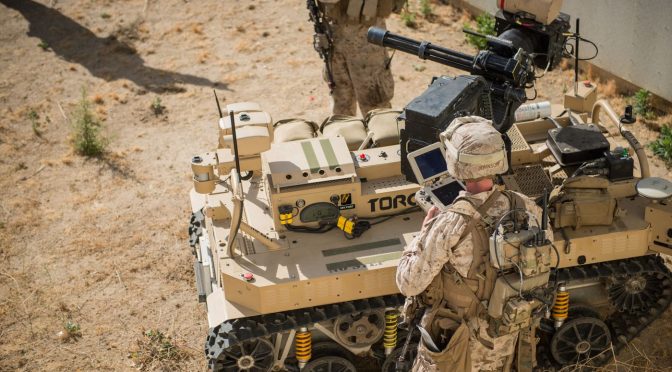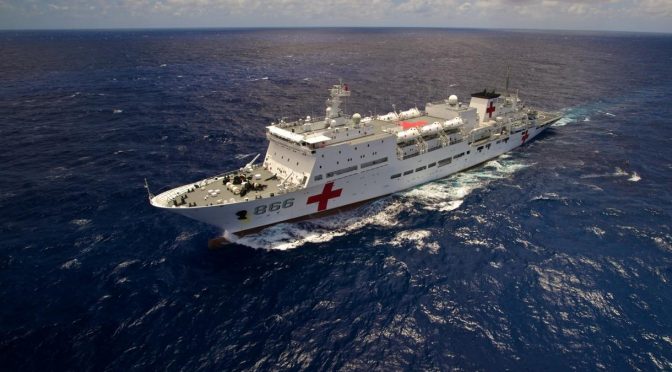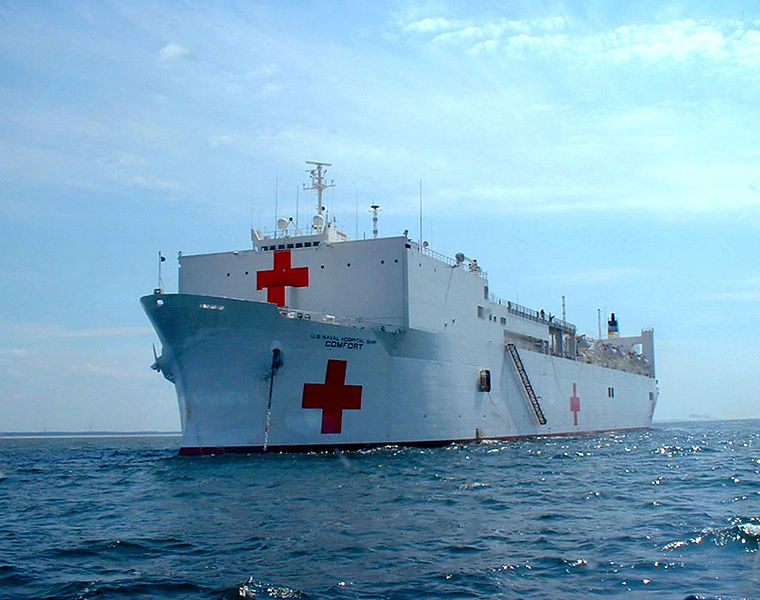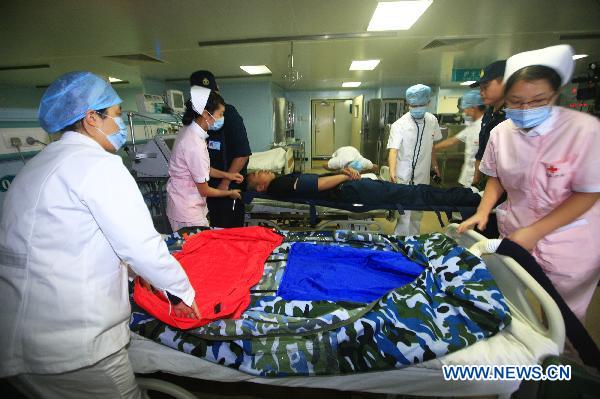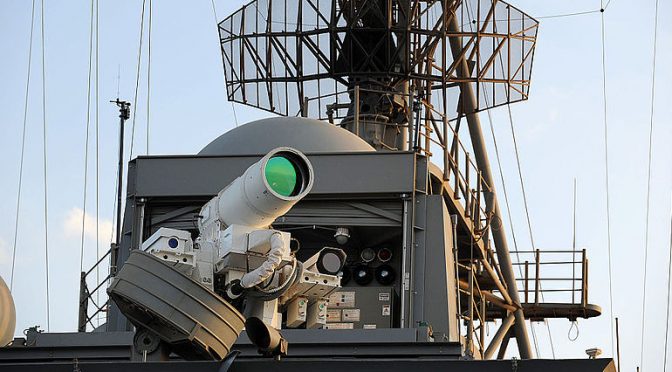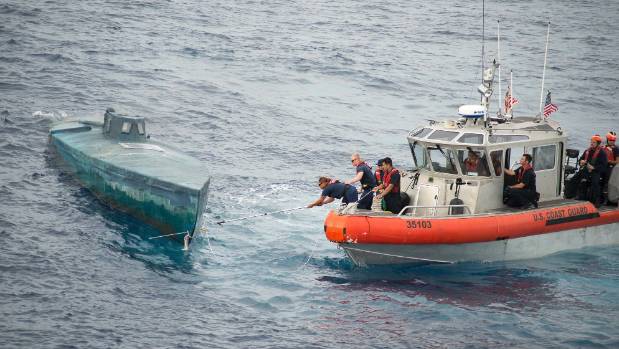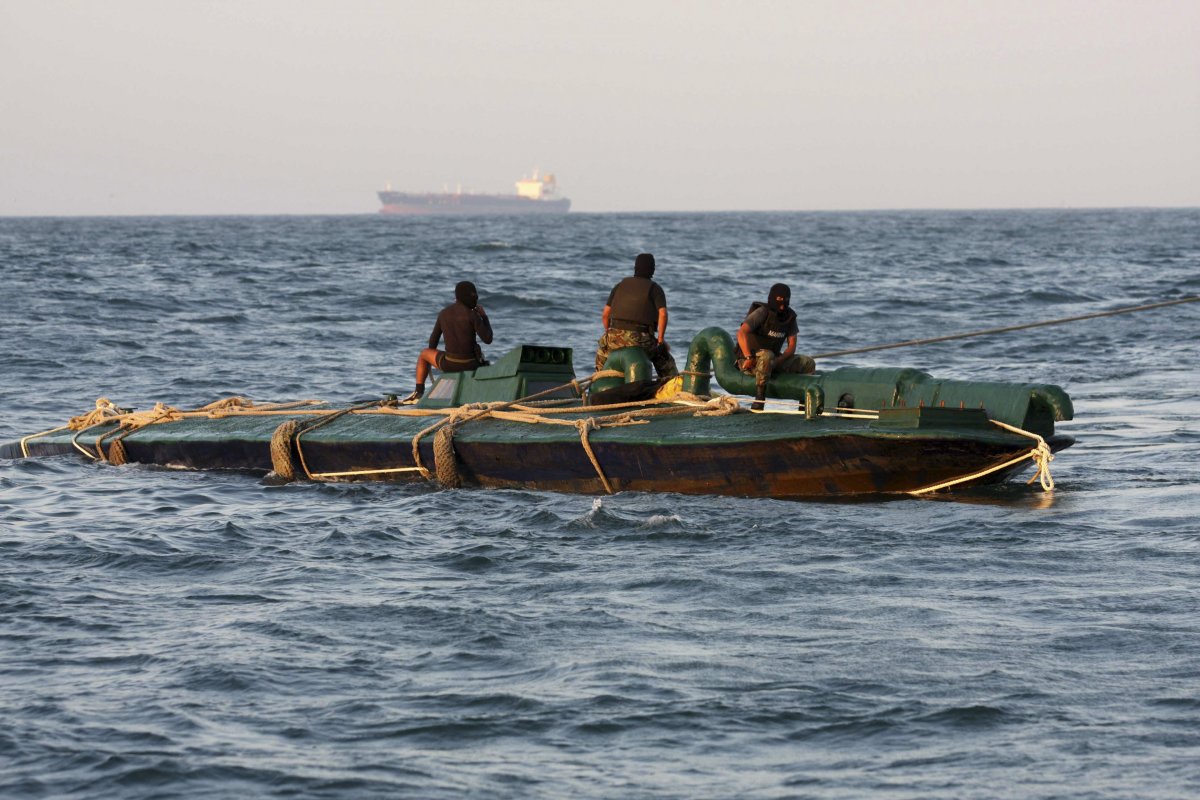By George Galdorisi
Perspective
In 2018 the United States remains engaged worldwide. The 2017 National Security Strategy addresses the wide-range of threats to the security and prosperity of United States.1 These threats range from high-end peer competitors such as China and Russia, to rogue regimes such as North Korea and Iran, to the ongoing threat of terrorism represented by such groups as ISIL. In a preview of the National Security Strategy at the December 2017 Reagan National Defense Forum, National Security Advisor General H.R. McMaster highlighted these threats and reconfirmed the previous administration’s “4+1” strategy, naming the four countries – Russia, China, Iran and North Korea—and the “+1” — terrorists, particularly ISIL — as urgent threats that the United States must deal with today.2
The U.S. military is dealing with this threat landscape by deploying forces worldwide at an unprecedented rate. And in most cases, it is naval strike forces, represented by carrier strike groups centered on nuclear-powered aircraft carriers, and expeditionary strike groups built around large-deck amphibious ships, that are the forces of choice for dealing with crises worldwide.
For decades, when a crisis emerged anywhere on the globe, the first question a U.S. president asked was, “Where are the carriers?” Today, that question is still asked, but increasingly, the question has morphed into, “Where are the expeditionary strike groups?” The reasons for this focus on expeditionary strike groups are clear. These naval expeditionary formations have been the ones used extensively for a wide-array of missions short of war, from anti-piracy patrols, to personnel evacuation, to humanitarian assistance and disaster relief. And where tensions lead to hostilities, these forces are the only ones that give the U.S. military a forcible entry option.
During the past decade-and-a-half of wars in the Middle East and South Asia, the U.S. Marine Corps was used extensively as a land force and did not frequently deploy aboard U.S. Navy amphibious ships. Now the Marine Corps is largely disengaged from those conflicts and is, in the words of a former commandant of the U.S. Marine Corps, “Returning to its amphibious roots.”3 As this occurs, the Navy-Marine Corps team is looking to new technology to complement and enhance the capabilities its amphibious ships bring to the fight.
Naval Expeditionary Forces: Embracing Unmanned Vehicles
Because of their “Swiss Army Knife” utility, U.S. naval expeditionary forces have remained relatively robust even as the size of the U.S. Navy has shrunk from 594 ships in 1987 to 272 ships in early 2018. Naval expeditionary strike groups comprise a substantial percentage of the U.S. Navy’s current fleet. And the blueprint for the future fleet the U.S. Navy is building maintains, and even increases, that percentage of amphibious ships.4
However, ships are increasingly expensive and U.S. Navy-Marine Corps expeditionary forces have been proactive in looking to new technology to add capability to their ships. One of the technologies that offer the most promise in this regard is that of unmanned systems. The reasons for embracing unmanned systems stem from their ability to reduce the risk to human life in high-threat areas, to deliver persistent surveillance over areas of interest, and to provide options to warfighters that derive from the inherent advantages of unmanned technologies—especially their ability to operate autonomously.
The importance of unmanned systems to the U.S. Navy’s future has been highlighted in a series of documents, ranging from the 2015 A Cooperative Strategy for 21st Century Seapower, to the 2016 A Design for Maintaining Maritime Superiority, to the 2017 Chief of Naval Operations’ The Future Navy white paper. The Future Navy paper presents a compelling case for the rapid integration of unmanned systems into the Navy Fleet, noting, in part:
“There is no question that unmanned systems must also be an integral part of the future fleet. The advantages such systems offer are even greater when they incorporate autonomy and machine learning….Shifting more heavily to unmanned surface, undersea, and aircraft will help us to further drive down unit costs.”5
The U.S. Navy’s commitment to and growing dependence on unmanned systems is also seen in the Navy’s official Force Structure Assessment of December 2016, as well as in a series of “Future Fleet Architecture Studies.” In each of these studies—one by the Chief of Naval Operations staff, one by the MITRE Corporation, and one by the Center for Strategic and Budgetary Assessments—the proposed Navy future fleet architecture had large numbers of air, surface, and subsurface unmanned systems as part of the Navy force structure. Indeed, these reports highlight the fact that the attributes unmanned systems can bring to the U.S. Navy Fleet circa 2030 have the potential to be truly transformational.6
The Navy Project Team, Report to Congress: Alternative Future Fleet Platform Architecture Study is an example of the Navy’s vision for the increasing use of unmanned systems. This study notes that under a distributed fleet architecture, ships would deploy with many more unmanned surface (USV) and air (UAV) vehicles, and submarines would employ more unmanned underwater vehicles (UUVs). The distributed Fleet would also include large, self-deployable independent USVs and UUVs, increasing unmanned deployed presence to approximately 50 platforms.
This distributed Fleet study calls out specific numbers of unmanned systems that would complement the manned platforms projected to be part of the U.S. Navy inventory by 2030:
- 255 Conventional take-off UAVs
- 157 Vertical take-off UAVs
- 88 Unmanned surface vehicles
- 183 Medium unmanned underwater vehicles
- 48 Large unmanned underwater vehicles
By any measure the number of air, surface, and subsurface unmanned vehicles envisioned in the Navy alternative architecture studies represents not only a step-increase in the number of unmanned systems in the Fleet today, but also vastly more unmanned systems than current Navy plans call for. But it is one thing to state the aspiration for more unmanned systems in the Fleet, and quite another to develop and deploy them. There are compelling reasons why naval expeditionary forces have been proactive in experimenting with emerging unmanned systems.
Testing and Evaluating Unmanned Systems
While the U.S. Navy and Marine Corps have embraced unmanned systems of all types into their force structures, and a wide-range of studies looking at the makeup of the Sea Services in the future have endorsed this shift, it is the Navy-Marine Corps expeditionary forces that have been the most active in evaluating a wide variety of unmanned systems in various exercises, experiments, and demonstrations. Part of the reason for this accelerated evaluation of emerging unmanned systems is the fact that, unlike carrier strike groups that have access to unmanned platforms such as MQ-4C Triton and MQ-8 Fire Scout, expeditionary strike groups are not similarly equipped.
While several such exercises, experiments, and demonstrations occurred in 2017, two of the most prominent, based on the scope of the events, as well as the number of new technologies introduced, were the Ship-to-Shore Maneuver Exploration and Experimentation (S2ME2) Advanced Naval Technology Exercise (ANTX), and Bold Alligator 2017. These events highlighted the potential of unmanned naval systems to be force-multipliers for expeditionary strike groups.
S2ME2 ANTX provided an opportunity to demonstrate emerging, innovative technology that could be used to address gaps in capabilities for naval expeditionary strike groups. As there are few missions that are more hazardous to the Navy-Marine Corps team than putting troops ashore in the face of a prepared enemy force, the experiment focused specifically on exploring the operational impact of advanced unmanned maritime systems on the amphibious ship-to-shore mission.
For the amphibious assault mission, UAVs are useful—but are extremely vulnerable to enemy air defenses. UUVs are useful as well, but the underwater medium makes control of these assets at distance problematic. For these reasons, S2ME2 ANTX focused heavily on unmanned surface vehicles to conduct real-time ISR (intelligence, surveillance, and reconnaissance) and IPB (intelligence preparation of the battlespace) missions. These are critical missions that have traditionally been done by our warfighters, but ones that put them at extreme risk.

In an October 2017 interview with U.S. Naval Institute News, the deputy assistant secretary of the Navy for research, development, test and evaluation, William Bray, stressed the importance of using unmanned systems in the ISR and IPB roles:
“Responding to a threat today means using unmanned systems to collect data and then delivering that information to surface ships, submarines, and aircraft. The challenge is delivering this data quickly and in formats allowing for quick action.”7
During the assault phase of S2ME2 ANTX, the expeditionary commander used a USV to thwart enemy defenses. For this event, he used an eight-foot man-portable MANTAS USV (one of a family of stealthy, low profile, USVs) that swam undetected into the “enemy harbor” (the Del Mar Boat Basin on the Southern California coast), and relayed information to the amphibious force command center using its TASKER C2 system. Once this ISR mission was complete, the MANTAS USV was driven to the surf zone to provide IPB on obstacle location, beach gradient, water conditions and other information crucial to planners.
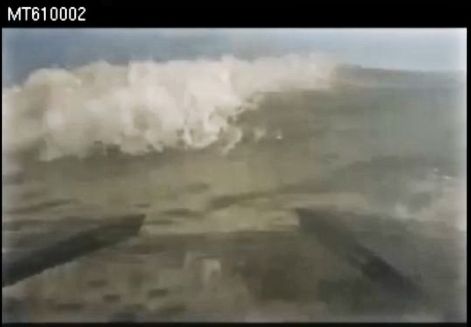
Carly Jackson, SPAWAR Systems Center Pacific’s director of prototyping for Information Warfare and one of the organizers of S2ME2, explained the key element of the exercise was to demonstrate new technology developed in rapid response to real-world problems facing the Fleet:
“This is a relatively new construct where we use the Navy’s organic labs and warfare centers to bring together emerging technologies and innovation to solve a very specific fleet force fighting problem. It’s focused on ‘first wave’ and mainly focused on unmanned systems with a big emphasis on intelligence gathering, surveillance, and reconnaissance.”8
The CHIPS interview article discussed the technologies on display and in demonstration at the S2ME2 ANTX event, especially networked autonomous air and maritime vehicles and ISR technologies. Tracy Conroy, SPAWAR Systems Center Pacific’s experimentation director, noted, “The innovative technology of unmanned vehicles offers a way to gather information that ultimately may help save lives. We take less of a risk of losing a Marine or Navy SEAL.”
S2ME2 ANTX was a precursor to Bold Alligator 2017, the annual Navy-Marine Corps expeditionary exercise. Bold Alligator 2017 was a live, scenario-driven exercise designed to demonstrate maritime and amphibious force capabilities, and was focused on planning and conducting amphibious operations, as well as evaluating new technologies that support the expeditionary force.9
Bold Alligator 2017 encompassed a substantial geographic area in the Virginia and North Carolina OPAREAS. The mission command center was located at Naval Station Norfolk, Virginia. The amphibious force and other units operated eastward of North and South Onslow Beaches, Camp Lejeune, North Carolina. For the littoral mission, some expeditionary units operated in the Intracoastal Waterway near Camp Lejeune.
The Bold Alligator 2017 scope was modified in the wake of Hurricanes Harvey, Irma and Maria, as many of the assets scheduled to participate were used for humanitarian assistance and disaster relief. The exercise featured a smaller number of amphibious forces but did include a carrier strike group.10 The 2nd Marine Expeditionary Brigade (MEB) orchestrated events and was embarked aboard USS Arlington (LPD-24), USS Fort McHenry (LSD-43), and USS Gunston Hall (LSD-44).
The 2nd MEB used a large (12-foot) MANTAS USV, equipped with a Gyro Stabilized SeaFLIR230 EO/IR Camera and a BlueView M900 Forward Looking Imaging Sonar to provide ISR and IPB for the amphibious assault. The sonar was employed to provide bottom imaging of the surf zone, looking for objects and obstacles—especially mine-like objects—that could pose a hazard to the landing craft–LCACs and LCUs–as they moved through the surf zone and onto the beach.
The early phases of Bold Alligator 2017 were dedicated to long-range reconnaissance. Operators at exercise command center at Naval Station Norfolk drove the six-foot and 12-foot MANTAS USVs off North and South Onslow Beaches, as well as up and into the Intracoastal Waterway. Both MANTAS USVs streamed live, high-resolution video and sonar images to the command center. The video images showed vehicles, personnel, and other objects on the beaches and in the Intracoastal Waterway, and the sonar images provided surf-zone bottom analysis and located objects and obstacles that could provide a hazard during the assault phase.
Bold Alligator 2017 underscored the importance of surface unmanned systems to provide real-time ISR and IPB early in the operation. This allowed planners to orchestrate the amphibious assault to ensure that the LCACs or LCUs passing through the surf zone and onto the beach did not encounter mines or other objects that could disable—or even destroy—these assault craft. Providing decision makers not on-scene with the confidence to order the assault was a critical capability and one that will likely be evaluated again in future amphibious exercises such as RIMPAC 2018, Valiant Shield 2018, Talisman Saber 2018, Bold Alligator 2018 and Cobra Gold, among others.
Navy Commitment to Unmanned Maritime Systems
One of the major challenges to the Navy making a substantial commitment to unmanned maritime systems is the fact that they are relatively new and their development has been “under the radar” for all but a few professionals in the science and technology (S&T), research and development (R&D), requirements, and acquisition communities. This lack of familiarity creates a high bar for unmanned naval systems in particular. A DoD Unmanned Systems Integrated Roadmap provided a window into the magnitude of this challenge:
“Creation of substantive autonomous systems/platforms within each domain will create resourcing and leadership challenges for all the services, while challenging their respective warfighter culture as well…Trust of unmanned systems is still in its infancy in ground and maritime systems….Unmanned systems are still a relatively new concept….As a result; there is a fear of new and unproven technology.”11
In spite of these concerns—or maybe because of them—the Naval Sea Systems Command and Navy laboratories have been accelerating the development of USVs and UUVs. The Navy has partnered with industry to develop, field, and test a family of USVs and UUVs such as the Medium Displacement Unmanned Surface Vehicle (“Sea Hunter”), MANTAS next-generation unmanned surface vessels, the Large Displacement Unmanned Underwater Vehicle (LDUUV), and others.
Indeed, this initial prototype testing has been so successful that the Department of the Navy has begun to provide increased support for USVs and UUVs and has established program guidance for many of these systems important to the Navy and Marine Corps. This programmatic commitment is reflected in the 2017 Navy Program Guide as well as in the 2017 Marine Corps Concepts and Programs publications. Both show a commitment to unmanned systems programs.12
In September 2017, Captain Jon Rucker, the program manager of the Navy program office (PMS-406) with stewardship over unmanned maritime systems (unmanned surface vehicles and unmanned underwater vehicles), discussed his programs with USNI News. The title of the article, “Navy Racing to Test, Field, Unmanned Maritime Vehicles for Future Ships,” captured the essence of where unmanned maritime systems will fit in tomorrow’s Navy, as well as the Navy-after-next. Captain Rucker shared:
“In addition to these programs of record, the Navy and Marine Corps have been testing as many unmanned vehicle prototypes as they can, hoping to see the art of the possible for unmanned systems taking on new mission sets. Many of these systems being tested are small surface and underwater vehicles that can be tested by the dozens at tech demonstrations or by operating units.”13
While the Navy is committed to several programs of record for large unmanned maritime systems such as the Knifefish UUV, the Common Unmanned Surface Vehicle (CUSV), the Large Displacement UUV (LDUUV) and Extra Large UUV (XLUUV), and the Anti-Submarine Warfare Continuous Trail Unmanned Vessel (ACTUV) vehicle (since renamed the Medium Displacement USV [MDUSV] and also called Sea Hunter), the Navy also sees great potential in expanding the scope of unmanned maritime systems testing:
“Rucker said a lot of the small unmanned vehicles are used to extend the reach of a mission through aiding in communications or reconnaissance. None have become programs of record yet, but PMS 406 is monitoring their development and their participation in events like the Ship-to-Shore Maneuver Exploration and Experimentation Advanced Naval Technology Exercise, which featured several small UUVs and USVs.”14
The ship-to-shore movement of an expeditionary assault force remains the most hazardous mission for any navy. Real-time ISR and IPB will spell the difference between victory and defeat. For this reason, the types of unmanned systems the Navy and Marine Corps should acquire are those systems that directly support our expeditionary forces. This suggests a need for unmanned surface systems to complement expeditionary naval formations. Indeed, USVs might well be the bridge to the Navy-after-next.
Captain George Galdorisi (USN – retired) is a career naval aviator whose thirty years of active duty service included four command tours and five years as a carrier strike group chief of staff. He began his writing career in 1978 with an article in U.S. Naval Institute Proceedings. He is the Director of Strategic Assessments and Technical Futures at the Navy’s Command and Control Center of Excellence in San Diego, California.
The views presented are those of the author, and do not reflect the views of the Department of the Navy or Department of Defense.
Correction: Two pictures and a paragraph were removed by request.
References
[1] National Security Strategy of the United States of America (Washington, D.C.: The White House, December 2017) accessed at: https://www.whitehouse.gov/wp-content/uploads/2017/12/NSS-Final-12-18-2017-0905-2.pdf.
[2] There are many summaries of this important national security event. For one of the most comprehensive, see Jerry Hendrix, “Little Peace, and Our Strength is Ebbing: A Report from the Reagan National Defense Forum,” National Review, December 4, 2017, accessed at: http://www.nationalreview.com/article/454308/us-national-security-reagan-national-defense-forum-offered-little-hope.
[3] Otto Kreisher, “U.S. Marine Corps Is Getting Back to Its Amphibious Roots,” Defense Media Network, November 8, 2012, accessed at: https://www.defensemedianetwork.com/stories/return-to-the-sea/.
[4] For a most comprehensive summary of U.S. Navy shipbuilding plans, see Ron O’Rourke Navy Force Structure and Shipbuilding Plans: Background and Issues for Congress (Washington, D.C.: Congressional Research Service, November 22, 2017).
[5] The Future Navy (Washington, D.C.: Department of the Navy, May 2017) accessed at: http://www.navy.mil/navydata/people/cno/Richardson/Resource/TheFutureNavy.pdf. See also, 2018 U.S. Marine Corps S&T Strategic Plan (Quantico, VA: U.S. Marine Corps Warfighting Lab, 2018) for the U.S. Marine Corps emphasis on unmanned systems, especially man-unmanned teaming.
[6] See, for example, Navy Project Team, Report to Congress: Alternative Future Fleet Platform Architecture Study, October 27, 2016, MITRE, Navy Future Fleet Platform Architecture Study, July 1, 2016, and CSBA, Restoring American Seapower: A New Fleet Architecture for the United States Navy, January 23, 2017.
[7] Ben Werner, “Sea Combat in High-End Environments Necessitates Open Architecture Technologies,” USNI News, October 19, 2017, accessed at: https://news.usni.org/2017/10/19/open-architecture-systems-design-is-key-to-navy-evolution?utm_source=USNI+News&utm_campaign=b535e84233-USNI_NEWS_DAILY&utm_medium=email&utm_term=0_0dd4a1450b-b535e84233-230420609&mc_cid=b535e84233&mc_eid=157ead4942
[8] Patric Petrie, “Navy Lab Demonstrates High-Tech Solutions in Response to Real-World Challenges at ANTX17,” CHIPS Magazine Online, May 5, 2017, accessed at http://www.doncio.navy.mil/CHIPS/ArticleDetails.aspx?id=8989.
[9] Information on Bold Alligator 2017 is available on the U.S. Navy website at: http://www.navy.mil/submit/display.asp?story_id=102852.
[10] Phone interview with Lieutenant Commander Wisbeck, Commander, Fleet Forces Command, Public Affairs Office, November 28, 2017.
[11] FY 2009-2034 Unmanned Systems Integrated Roadmap, pp. 39-41.
[12] See, 2017 Navy Program Guide, accessed at: http://www.navy.mil/strategic/npg17.pdf, and 2017 Marine Corps Concepts and Programs accessed at: https://marinecorpsconceptsandprograms.com/.
[13] Megan Eckstein, “Navy Racing to Test, Field, Unmanned Maritime Vehicles for Future Ships,” USNI News, September 21, 2017, accessed at: https://news.usni.org/2017/09/21/navy-racing-test-field-unmanned-maritime-vehicles-future-ships?utm_source=USNI+News&utm_campaign=fb4495a428-USNI_NEWS_DAILY&utm_medium=email&utm_term=0_0dd4a1450b-fb4495a428-230420609&mc_cid=fb4495a428&mc_eid=157ead4942
[14] “Navy Racing to Test, Field, Unmanned Maritime Vehicles for Future Ships.”
Featured Image: Marines with 3rd Battalion, 5th Marine Regiment prepare a Weaponized Multi-Utility Tactical Transport vehicle for a patrol at Marine Corps Base Camp Pendleton, Calif., July 13, 2016. (USMC photo by Lance Cpl. Julien Rodarte)

